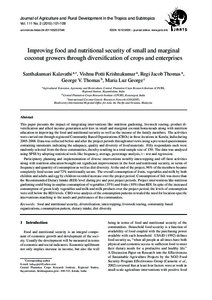| dc.date.accessioned | 2011-10-11T12:32:28Z | |
| dc.date.available | 2011-10-11T12:32:28Z | |
| dc.date.issued | 2011 | |
| dc.identifier.issn | 1612-9830 | |
| dc.identifier.uri | urn:nbn:de:hebis:34-2011052337546 | |
| dc.identifier.uri | http://hdl.handle.net/123456789/2011052337546 | |
| dc.language.iso | eng | |
| dc.publisher | Kassel University Press | ger |
| dc.rights | Urheberrechtlich geschützt | |
| dc.rights.uri | https://rightsstatements.org/page/InC/1.0/ | |
| dc.subject | food and nutritional security | eng |
| dc.subject | diversification | eng |
| dc.subject | intercropping | eng |
| dc.subject | livestock rearing | eng |
| dc.subject | community based organizations | eng |
| dc.subject | consumption pattern | eng |
| dc.subject | dietary intake | eng |
| dc.subject | diet diversity | eng |
| dc.subject.ddc | 630 | |
| dc.title | Improving food and nutritional security of small and marginal coconut growers through diversification of crops and enterprises | eng |
| dc.type | Aufsatz | |
| dcterms.abstract | This paper presents the impact of integrating interventions like nutrition gardening, livestock rearing, product diversification and allied income generation activities in small and marginal coconut homesteads along with nutrition education in improving the food and nutritional security as well as the income of the family members. The activities were carried out through registered Community Based Organizations (CBOs) in three locations in Kerala, India during 2005-2008. Data was collected before and after the project periods through interviews using a pre-tested questionnaire containing statements indicating the adequacy, quality and diversity of food materials. Fifty respondents each were randomly selected from the three communities, thereby resulting in a total sample size of 150. The data was analysed using SPSS by adopting statistical tools like frequency, average, percentage analysis, t – test and regression. Participatory planning and implementation of diverse interventions notably intercropping and off-farm activities along with nutrition education brought out significant improvements in the food and nutritional security, in terms of frequency and quantity of consumption as well as diet diversity. At the end of the project, 96%of the members became completely food secure and 72% nutritionally secure. The overall consumption of fruits, vegetables and milk by both children and adults and egg by children recorded increase over the project period. Consumption of fish was more than the Recommended Dietary Intake (RDI) level during pre and post project periods. Project interventions like nutrition gardening could bring in surplus consumption of vegetables (35%) and fruits (10%) than RDI. In spite of the increased consumption of green leafy vegetables and milk and milk products over the project period, the levels of consumption were still below the RDI levels. CBO-wise analysis of the consumption patterns revealed the need for location-specific interventions matching to the needs and preferences of the communities. | eng |
| dcterms.accessRights | open access | |
| dcterms.bibliographicCitation | In: Journal of Agriculture and Rural Development in the Tropics and Subtropics. Kassel : Kassel University Press. - Vol. 111, No. 2 (2010), S. 101-109 | |
| dcterms.creator | Kalavathi, Santhakumari | |
| dcterms.creator | Krishnakumar, Vishnu Potti | |
| dcterms.creator | Thomas, Regi Jacob | |
| dcterms.creator | Thomas, George V. | |
| dcterms.creator | George, Maria Luz | |
| dc.description.everything | Gedruckte Ausg. im Verlag Kassel Univ. Press (www.upress.uni-kassel.de) erschienen. | ger |

